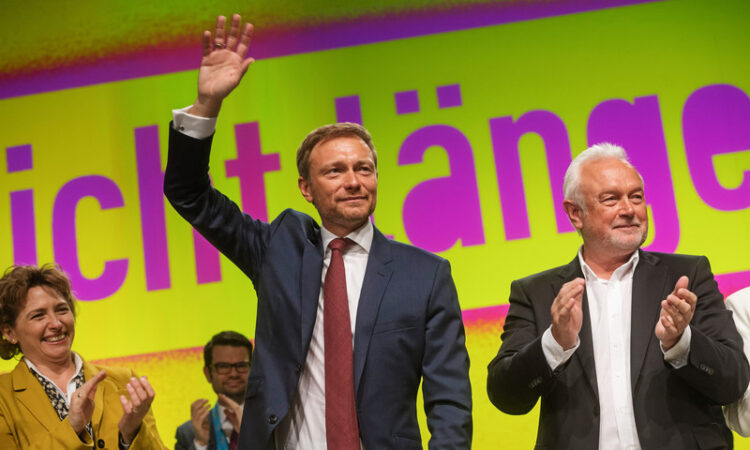
It is all but certain that much of the EU is heading towards austerity in 2024.
With record high-interest rates, and worn out by a year of protracted debates about fiscal rules, even the least frugal governments have now accepted the reimposition of hard debt-and-deficit limits that will see about half of all EU members having to impose budget cuts in 2024.
Before we dive into that, it is worthwhile looking back for a minute to the end of 2022 when we were still wondering whether the EU’s ambitious spending plans would survive a tug-of-war with the European Central Bank (ECB).
EU Commission president Ursula von der Leyen had just announced another massive bail-out of the economy.
She pledged to defeat Russia’s “economic war” with copious subsidies under RepowerEU and said she would counter US and Chinese competition with beefed-up green and technological spending.
To legitimise the necessary extra spending, she proposed debt rules that would be more flexible. “We have to acknowledge a new reality of higher debt levels,” she told the press at the time.
To make it all happen, she invoked the massive Covid-19 spending package, launched in 2020, as a model for solving the energy and climate crisis in the long term.
The system she sketched would allow national capitals to submit budget and investment plans, which the commission would then approve and monitor.
At the middle of it all would be a new EU sovereignty fund that would give the EU itself the fiscal firepower it needed to help economically weaker members deal with crises longer term — similar in set up, if perhaps not in scope, to the €800bn Covid-19 recovery fund.
In the latest iteration of the EU’s hard-fought fiscal rules, the sovereignty fund has all but disappeared from the EU Council text. First replaced by a far smaller €10bn fund, now only €1.5bn is left to help the EU’s 450 million citizens deal with external geopolitical and environmental shocks.
Benchmarks are back
But the real bugbear for anyone still daring to dream big are the so-called generic numerical ‘benchmarks’ for debt reduction, which found their way back into the agreement.
This has been insisted on by Germany’s finance minister, Christian Lindner, from the neo-liberal FDP, and requires countries with deficits above three percent of GDP to reduce their deficits by at least 0.5 percent of GDP per year.
Exact calculations of the impacts are still subject to changes in the text. Still, it is clear Italian and French finance ministers would need to make cuts that Jeromin Zellmeyer, director of the influential Brussels-based think tank Bruegel, recently described as “completely crazy.”
Climate investments are one of the first casualties of this renewed focus on debt reduction. Empirical evidence from the Organization for Economic Cooperation and Development (OECD) showed that spending cuts crowd out long-term investments.
This is a problem because annual green investments in Europe amount to €475bn annually, about half of which must come from public coffers.
And budget consolidation is already causing governments to cut back on their green ambitions.
Germany, for example, now facing a budgetary crisis of its own making, has cut €45bn from its climate and transformation projects every year until 2027.
The last-minute budget cuts were made after the constitutional court ruled the off-balance funds to circumvent the constitutional debt brake was illegal.
These cuts will further diminish growth in Germany. By the end of 2024, the eurozone’s largest economy will most likely not have grown since 2019.
Germans have also experienced a dramatic decline in real wages since the beginning of Covid-19.
According to a recent US treasury report, US wages have grown 2.8 percent since 2019. During the same period, German workers lost 7.1 percent in real wages in 2023 compared to 2019. Only Italy did worse, with a 9.1 percent wage loss.
According to the International Monetary Fund, Germany is now on track for a recession, and escaping from this will most likely require more investment, not less.
But even with Germany’s debt ratio of 60 percent to GDP, the lowest amongst large developed economies, Lindner has shown himself determined to impose more spending cuts.
“I can definitely think of more areas to cut spending,” he told the German press just before Christmas.
Boom time for far-right
With this, no one should be surprised by a far-right surge across Europe in 2024.
Public spending cuts are shown to substantially increase extreme voting—especially on the right, as far-right parties have increasingly blamed immigrants for worsening public services and housing shortages in their rhetoric. But it is past austerity that is to blame.
During the austerity years of the 2010s, public services deprivation has been linked to a surge in far-right support in Italy, currently run by Giorgia Meloni’s neo-fascist Fratelli d’Italia.
A similar effect is noticeable in Germany.
According to the European ratings agency Scope Ratings, Germany’s under-investment compared to other major economies since the country’s ruinous debt-brake was introduced in 2009 amounts to €300bn. Germany’s failure to invest in infrastructure, renewables, and digitalisation has contributed to the country having one of the lowest growth rates in Europe, adding to a general sense of economic decline.
This has helped far-right Alternative für Deutschland (AfD), which has now overtaken all governing parties in the polls, riding high on an anti-immigrant, anti-green agenda. However, the AfD is itself supportive of low-deficit policies of the past, showing how austerity can lead to the electoral success of parties promising more austerity. Not just in Germany.
A sustained contraction of spending in Europe’s largest economy pulls down the bloc as a whole, threatening the ambitious investment plans that have characterised the EU since 2019. This chips away at Europe’s competitive edge as China and the US, both unhampered by self-imposed spending limits, continue to pour investments into advancing their strategic industries.






